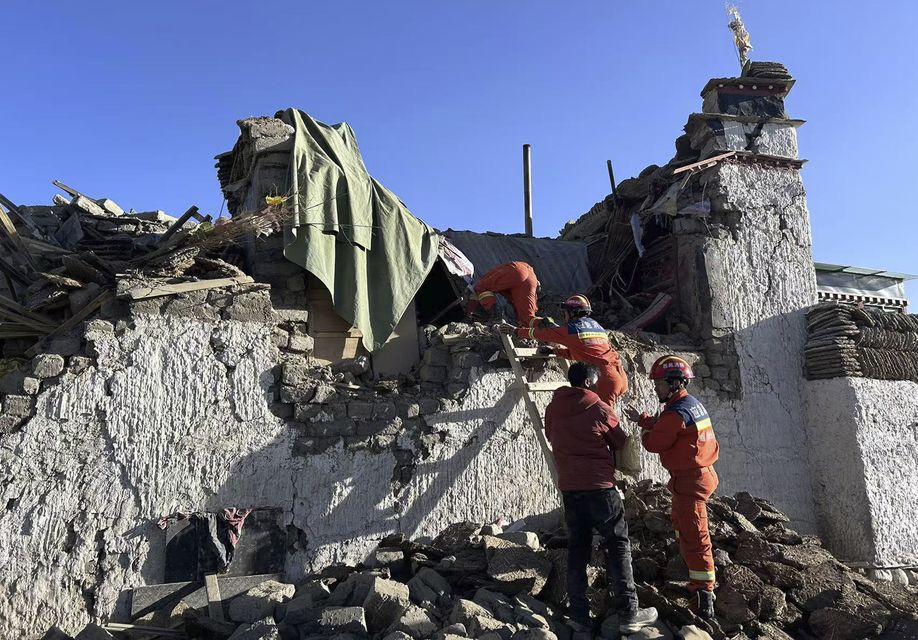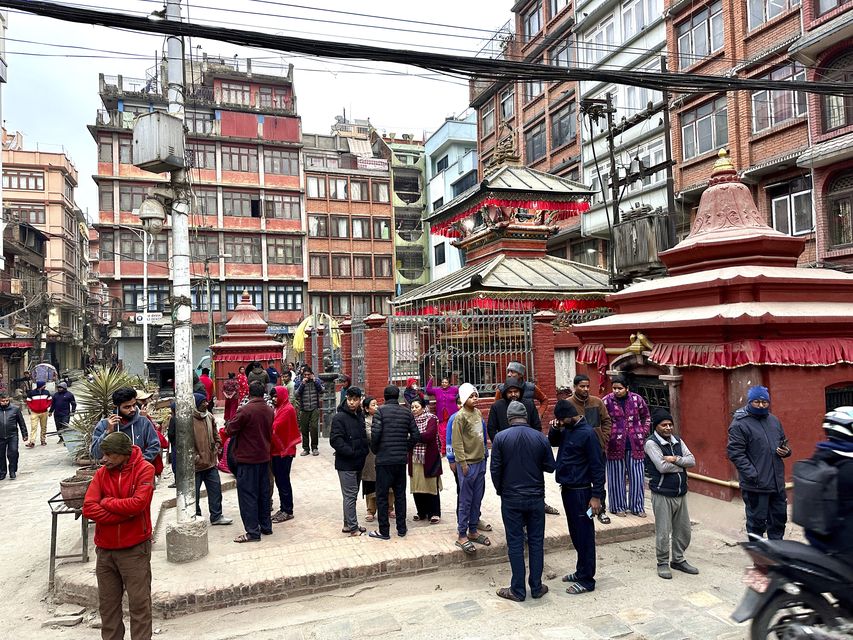A strong earthquake shook a high-altitude region of western China and areas of Nepal on Tuesday, damaging hundreds of houses, littering streets with rubble and killing at least 126 people in Tibet.
Many others were trapped as dozens of aftershocks shook the remote region.
Rescue workers climbed mounds of broken bricks, some using ladders in heavily damaged villages, as they searched for survivors.
Rescue workers search for survivors in the aftermath of an earthquake in Changsuo Township of Dingri in Xigaze, southwestern China’s Tibet Autonomous Region (Xinhua via AP)
Videos posted by China’s Ministry of Emergency Management showed two people being carried on stretchers by workers treading over the debris from collapsed homes.
At least 188 people were injured in Tibet on the Chinese side of the border, the official Xinhua News Agency said.
More than 1,000 homes were damaged in the barren and sparsely populated region, state broadcaster CCTV reported.
In video posted by the broadcaster, building debris littered streets and crushed cars.
People in north-eastern Nepal strongly felt the earthquake, but there were no initial reports of injuries or damage, according to the country’s National Emergency Operation Center.
The area around Mount Everest, about 75 kilometres (50 miles) southwest of the epicentre, was empty in the depth of winter when even some residents move away to escape the cold.
Nepalese people stand after rushing out of their homes after experiencing an earthquake in Kathmandu, Nepal (Sunil Sharma/AP)
The quake woke up residents in Nepal’s capital of Kathmandu — about 230 kilometres (140 miles) from the epicentre — and sent them running into the streets.
The US Geological Survey said the earthquake measured magnitude 7.1 and was relatively shallow at a depth of about 10 kilometres (six miles).
China’s Earthquake Networks Centre recorded the magnitude as 6.8. Shallow earthquakes often cause more damage.
The epicentre was in Tibet’s Tingri county, where the India and Eurasia plates grind against each other and can cause earthquakes strong enough to change the heights of some of the world’s tallest peaks in the Himalayan mountains.
Tibet is part of China, but many Tibetans’ loyalties lie with the Dalai Lama, the spiritual leader who has lived in exile in India since a failed anti-Chinese uprising in 1959.
Western governments and human rights organisations have repeatedly accused the Chinese government of abuses in Tibet, where it has cracked down on dissent while investing heavily in economic development.
Rescue workers search for survivors in the aftermath of an earthquake in Changsuo Township of Dingri in Xigaze (AP)
There have been 10 earthquakes of at least magnitude 6 in the area where Tuesday’s quake hit over the past century, the USGS said.
About 150 aftershocks were recorded in the nine hours after the earthquake, and the Mount Everest scenic area on the Chinese side was closed.
Chinese leader Xi Jinping called for all-out efforts to rescue people, minimise casualties and resettle those whose homes were damaged.
More than 3,000 rescuers were deployed, CCTV said.
Vice Premier Zhang Guoqing was dispatched to the area to guide the work, and the government announced the allocation of 100 million yuan (£10.8 million) for disaster relief.
About 6,900 people live in three townships and 27 villages within 20 kilometres (12.5 miles) of the epicentre on the Chinese side, state media said.
The average altitude in the area is about 4,200 meters (13,800 feet), the Chinese earthquake centre said in a social media post.
On the south-west edge of Kathmandu, a video showed water spilling out into the street from a pond in a courtyard with a small temple.
“It is a big earthquake,” a woman can be heard saying. “People are all shaking”.

